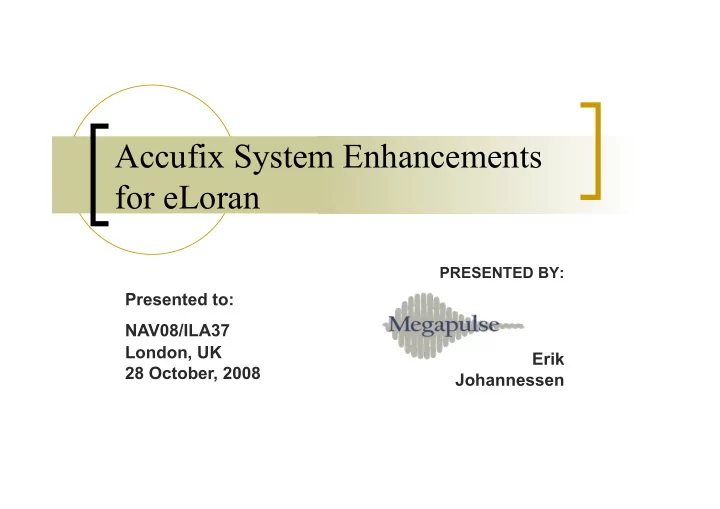

Accufix System Enhancements for eLoran PRESENTED BY: Presented to: NAV08/ILA37 London, UK Erik 28 October, 2008 Johannessen
Overview Brief description of Accufix transmitter means of pulse generation and control eLoran evolving signal standards Audit of Accufix performance for eLoran Evolution of Accufix design Impact to existing owners and operators Summary Megapulse Incorporated October, 2008
Accufix Pulse Generation and Control Megapulse Incorporated October, 2008
Accufix Pulse Generation and Control C1 Voltage C2 Voltage DHC Current Megapulse Incorporated October, 2008
Accufix Pulse Generation and Control Megapulse Incorporated October, 2008
Consequence of eLoran Standards Performance requirements evolving Some new performance requirements are expressed in terms of the 1, 5, & 10 second exponential averages needed by mode and also in the intra-pulse timing stability requirements. More to follow? Receiver manufacturers want generally tighter tolerances everywhere to reduce the problems they already have to deal with. Megapulse Incorporated October, 2008
Accufix 7500 Assessment – Test Set-Up Megapulse Incorporated October, 2008
Accufix 7500 Assessment – Test Set-Up Baseline measurements Single and Dual (multiple pairs) rate, full power Test measurements TCS switchovers Coupling/Output Networks switchovers Effect of mistuned Coupling networks Tuning bumps HCG Maintenance Blink mode Pulse to Pulse timing Analyzed >7.5 Million pulses Megapulse Incorporated October, 2008
Test Data – Baseline “All Good” Condition The 10 second exponential average of all navigation pulses shall be < 25 ns of UTC; Timing receiver requirement. Megapulse Incorporated October, 2008
Test Data – Baseline “All Good” Condition The 1 second exp. average of all navigation pulses <100 ns of UTC; Aviation (RNP 0.3) requirement. The peak to peak variation of 5 second exp. average of all navigation pulses <10 ns within 20 minute period; Maritime HEA and Frequency requirement. Megapulse Incorporated October, 2008
Test Data – Baseline “All Good” Condition Values in the above table are in nanoseconds for a one hour data set of ~290,000 pulses. At the 5 second averaging interval (0.2Hz) all performance requirements are met. Effects of jitter and dispersion are visible in the raw and 5Hz (automatic blink setting?) data. Megapulse Incorporated October, 2008
Single Rate Dispersion for “All Good” 9960 Single Rate w/ 1 Sec Moving Ave Megapulse Incorporated October, 2008
Dual Rate Dispersion for “All Good” 9960 Dual Rate w/ 1 Sec Moving Ave Megapulse Incorporated October, 2008
Accufix 7500 Assessment – Tests Run Transmitter stability under simulated operating conditions is acceptable. The issue is thus managing the likely real expected & unexpected events including: Antenna system changes Maintenance practices Fault tolerance Redundancies Operational Concepts Megapulse Incorporated October, 2008
Test Data – Typical Conditions Tuner responds to changes in either the tank or antenna system and is measured by digital sampling of antenna ground return Megapulse Incorporated October, 2008
Test Data – Typical Conditions Pulse dispersion means that when two of eight pulses disappear in the blink sequence that there is a resulting timing bias Megapulse Incorporated October, 2008
Test Data – Typical Conditions HCG maintenance (common) or failure (rare) result in allocation dependent errors exhibiting a jump when turned off and a minor wobble when turned on. Megapulse Incorporated October, 2008
Test Data – Typical Conditions Ambiguity <25nsec exists in ToT from TCS. At start-up this is compensated with external loop but a commanded switchover may create an unnecessary timing jump Megapulse Incorporated October, 2008
Test Data – Typical Conditions The Coupling Output Switchover causes an interruption of triggers for ~2.5 seconds that results in a timing wobble with a duration of about 15 seconds Megapulse Incorporated October, 2008
Pulse Zero Crossing Stability Two allocations of DHC were tested Megapulse Incorporated October, 2008
Test Data & Analysis – Summary Megapulse Incorporated October, 2008
Test Summary with Solutions Megapulse Incorporated October, 2008
Accufix Power Supply Regulation C1 Voltage C1 Charging Current Megapulse Incorporated October, 2008
Accufix Power Supply Regulation C1 Charging Current E0 Voltage Single Rate C1 Voltage E0 Voltage Dual Rate Megapulse Incorporated October, 2008
Accufix Power Supply Regulation Present Concept - Phase Control The difference between E0 and “Set E0” is fed to the integrator; Output is compared with a ramp that is reset synchronously with “nulls” of line voltage; When the ramp voltage reaches the level established by the integrator, a comparator enables Gate Drive generator and capacitor C0 is charged; Revised Concept Continuous regulation of E0 Eliminates need for either ramp or feedback loop Verification through simulation Megapulse Incorporated October, 2008
Simulation of Power Supply Regulation E0 Voltage C1 Charging Current C1 Voltage (leading edge) C 0 C 1 23000uF 21uF Megapulse Incorporated October, 2008
Simulation of Power Supply Regulation 6500 1.75V 7500 .75V Megapulse Incorporated October, 2008
Simulation of Power Supply Regulation E0 Voltage C1 Charging Current C1 Voltage (Leading Edge) Megapulse Incorporated October, 2008
PS Redesign Expected Performance Shaded areas in yellow benefit Dispersion will be reduced on both single and dual rate Slow Dual Rate effect is eliminated Individual raw outliers will still exist but reduced in magnitude Permits tight tolerance on ABS (~25nsec) Applicable to AN/FPN-64 and Accufix 6500 Megapulse Incorporated October, 2008
Upgrade Path for Existing Systems Accufix 7500 (USCG post 2001) Minor power supply upgrade TCS software upgrade Accufix 6500 (NELS/FERNS 1990s) & Accufix 6500 (Saudi/China/France 1980s) & AN-FPN-64 various generations (USCG and CCG) Replace Power supply Replace Control Console (Except Niijima) Megapulse Incorporated October, 2008
Summary The Megapulse principle of pulse generation and control is elegantly simple New receiver technologies and higher performance requirements are placing new demands on the “certainty” of signal characteristics. These requirements are evolving through processes such as RTCM but hopefully will be firmed in the nearest future Existing and Modernized Loran systems must be upgraded to meet eLoran Megapulse Incorporated October, 2008
Recommend
More recommend